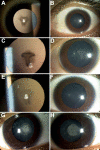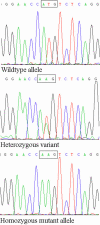Initiation codon mutation in betaB1-crystallin (CRYBB1) associated with autosomal recessive nuclear pulverulent cataract
- PMID: 19461930
- PMCID: PMC2684559
Initiation codon mutation in betaB1-crystallin (CRYBB1) associated with autosomal recessive nuclear pulverulent cataract
Abstract
Purpose: To identify the molecular basis for autosomal recessively inherited congenital non-syndromic pulverulent cataracts in a consanguineous family with four affected children.
Methods: An autozygosity mapping strategy using high density SNP microarrays and microsatellite markers was employed to detect regions of homozygosity. Subsequently good candidate genes were screened for mutations by direct sequencing.
Results: The SNP microarray data demonstrated a 24.96 Mb region of homozygosity at 22q11.21-22q13.2 which was confirmed by microsatellite marker analysis. The candidate target region contained the beta-crystallin gene cluster and direct sequencing in affected family members revealed a novel mutation in CRYBB1 (c.2T>A; p.Met1Lys).
Conclusions: To our knowledge this is the first case of an initiation codon mutation in a human crystallin gene, and only the second report of a CRYBB1 mutation associated with autosomal recessive congenital cataracts. In addition, although a number of genetic causes of autosomal dominant pulverulent cataracts have been identified (including CRYBB1) this is the first gene to have been implicated in autosomal recessive nuclear pulverulent cataract.
Figures



Similar articles
-
Homozygous CRYBB1 deletion mutation underlies autosomal recessive congenital cataract.Invest Ophthalmol Vis Sci. 2007 May;48(5):2208-13. doi: 10.1167/iovs.06-1019. Invest Ophthalmol Vis Sci. 2007. PMID: 17460281
-
A novel nonsense mutation in CRYBB1 associated with autosomal dominant congenital cataract.Mol Vis. 2008 Apr 18;14:727-31. Mol Vis. 2008. PMID: 18432316 Free PMC article.
-
A CRYGC gene mutation associated with autosomal dominant pulverulent cataract.Gene. 2013 Oct 15;529(1):181-5. doi: 10.1016/j.gene.2013.07.044. Epub 2013 Aug 14. Gene. 2013. PMID: 23954869
-
A novel mutation in CRYBB1 associated with congenital cataract-microcornea syndrome: the p.Ser129Arg mutation destabilizes the βB1/βA3-crystallin heteromer but not the βB1-crystallin homomer.Hum Mutat. 2011 Mar;32(3):E2050-60. doi: 10.1002/humu.21436. Epub 2011 Jan 25. Hum Mutat. 2011. PMID: 21972112 Free PMC article.
-
Potential role of βB1 crystallin in cataract formation:a systematic review.Arch Biochem Biophys. 2025 Aug;770:110463. doi: 10.1016/j.abb.2025.110463. Epub 2025 May 10. Arch Biochem Biophys. 2025. PMID: 40355021
Cited by
-
Inherited cataracts: Genetic mechanisms and pathways new and old.Exp Eye Res. 2021 Aug;209:108662. doi: 10.1016/j.exer.2021.108662. Epub 2021 Jun 12. Exp Eye Res. 2021. PMID: 34126080 Free PMC article. Review.
-
A novel missense mutation in the gene encoding major intrinsic protein (MIP) in a Giant panda with unilateral cataract formation.BMC Genomics. 2021 Feb 2;22(1):100. doi: 10.1186/s12864-021-07386-8. BMC Genomics. 2021. PMID: 33530927 Free PMC article.
-
NovelSNPer: A Fast Tool for the Identification and Characterization of Novel SNPs and InDels.Adv Bioinformatics. 2011;2011:657341. doi: 10.1155/2011/657341. Epub 2011 Oct 31. Adv Bioinformatics. 2011. PMID: 22110502 Free PMC article.
-
A novel mutation in the major intrinsic protein (MIP) associated with autosomal dominant congenital cataracts in a Chinese family.Mol Vis. 2010 Mar 25;16:534-9. Mol Vis. 2010. PMID: 20361015 Free PMC article.
-
Inherited Congenital Cataract: A Guide to Suspect the Genetic Etiology in the Cataract Genesis.Mol Syndromol. 2017 Mar;8(2):58-78. doi: 10.1159/000455752. Epub 2017 Feb 7. Mol Syndromol. 2017. PMID: 28611546 Free PMC article. Review.
References
-
- Rahi JS, Dezateux C. Measuring and interpreting the incidence of congenital ocular anomalies: lessons from a national study of congenital cataract in the UK. Invest Ophthalmol Vis Sci. 2001;42:1444–8. - PubMed
-
- Willoughby CE, Shafiq A, Ferrini W, Chan LL, Billingsley G, Priston M, Mok C, Chandna A, Kaye S, Héon E. CRYBB1 mutation associated with congenital cataract and microcornea. Mol Vis. 2005;11:587–93. - PubMed
-
- Graw J. Genetics of crystallins: Cataract and beyond. Exp Eye Res. 2009;88:173–89. - PubMed
Publication types
MeSH terms
Substances
Grants and funding
LinkOut - more resources
Full Text Sources
Medical
Miscellaneous
